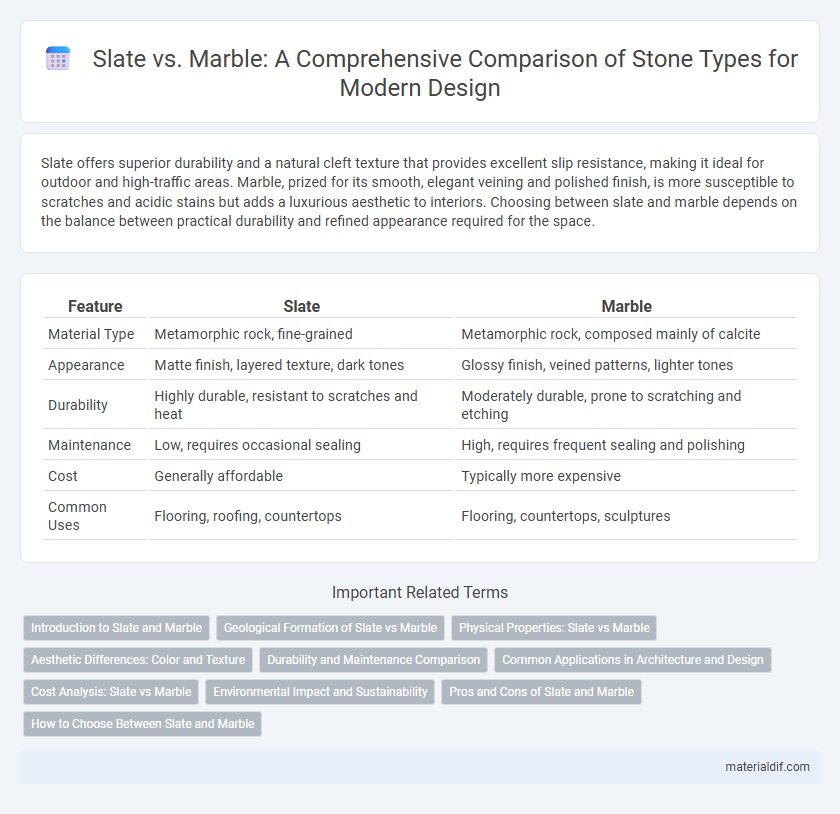Slate offers superior durability and a natural cleft texture that provides excellent slip resistance, making it ideal for outdoor and high-traffic areas. Marble, prized for its smooth, elegant veining and polished finish, is more susceptible to scratches and acidic stains but adds a luxurious aesthetic to interiors. Choosing between slate and marble depends on the balance between practical durability and refined appearance required for the space.
Table of Comparison
| Feature | Slate | Marble |
|---|---|---|
| Material Type | Metamorphic rock, fine-grained | Metamorphic rock, composed mainly of calcite |
| Appearance | Matte finish, layered texture, dark tones | Glossy finish, veined patterns, lighter tones |
| Durability | Highly durable, resistant to scratches and heat | Moderately durable, prone to scratching and etching |
| Maintenance | Low, requires occasional sealing | High, requires frequent sealing and polishing |
| Cost | Generally affordable | Typically more expensive |
| Common Uses | Flooring, roofing, countertops | Flooring, countertops, sculptures |
Introduction to Slate and Marble
Slate, a fine-grained metamorphic rock, forms from shale under low-grade regional metamorphism, characterized by its foliated texture and durability, making it ideal for roofing, flooring, and outdoor applications. Marble, a metamorphic rock derived from limestone, exhibits crystalline texture and is prized for its aesthetic appeal, featuring varied colors and veining patterns widely used in sculpture and interior design. Both stones differ in formation, texture, and typical uses, influencing their selection for architectural and decorative projects.
Geological Formation of Slate vs Marble
Slate forms through the low-grade metamorphism of shale or mudstone, involving intense pressure that realigns clay minerals into foliated layers, resulting in its characteristic fine-grained texture. Marble originates from the high-grade metamorphism of limestone or dolomite, where recrystallization of carbonate minerals produces a coarse-grained, non-foliated stone with interlocking calcite or dolomite crystals. The geological differences in metamorphic conditions and parent materials account for slate's foliation and durability versus marble's crystalline structure and susceptibility to weathering.
Physical Properties: Slate vs Marble
Slate exhibits a fine-grained, foliated texture with excellent cleavage, making it highly durable and resistant to breakage, which is ideal for roofing and flooring. Marble features a coarse crystalline structure with a soft, porous surface prone to scratching and etching, necessitating regular sealing for protection. Slate's higher density and low water absorption contrast with marble's moderate porosity, influencing its suitability for outdoor versus indoor applications.
Aesthetic Differences: Color and Texture
Slate presents a natural, earthy palette with deep grays, greens, and blacks, characterized by its fine-grained, layered texture that adds a rustic and matte finish to surfaces. Marble offers a more refined aesthetic, featuring a wide range of colors from pure white to rich veining patterns in shades of gray, pink, or green, distinguished by its smooth, polished surface that enhances elegance and luxury. The visual contrast between slate's rugged, textured appeal and marble's sleek, glossy finish defines their distinct design applications in interior and exterior spaces.
Durability and Maintenance Comparison
Slate offers superior durability due to its dense, fine-grained structure, making it resistant to scratches, cracks, and heat compared to marble. Marble, while elegant, requires frequent sealing and careful maintenance to prevent staining and etching caused by acids. Slate's low porosity reduces the need for intensive upkeep, positioning it as a practical choice for high-traffic or outdoor areas requiring long-lasting stone surfaces.
Common Applications in Architecture and Design
Slate is commonly used for roofing, flooring, and outdoor landscaping due to its durability and natural slip resistance. Marble, prized for its elegance and smooth finish, is frequently applied in interior wall cladding, countertops, and decorative sculptures. Both stones offer distinct aesthetic and functional benefits, influencing their typical roles in architectural and design projects.
Cost Analysis: Slate vs Marble
Slate typically costs between $4 and $10 per square foot, making it a more budget-friendly option compared to marble, which ranges from $10 to $30 per square foot depending on quality and origin. Installation costs for marble are generally higher due to its fragility and the specialized skills required, while slate is more durable and easier to install, reducing labor expenses. Overall, slate offers a cost-effective solution for flooring and countertops, whereas marble's higher price reflects its luxury appeal and aesthetic value.
Environmental Impact and Sustainability
Slate exhibits superior environmental sustainability compared to marble due to its lower energy consumption during quarrying and processing, resulting in a reduced carbon footprint. Slate is a natural, durable stone that requires minimal maintenance and can be sourced locally in many regions, decreasing transportation emissions. Marble extraction and refinement involve more intensive energy use and chemical treatments, contributing to greater environmental impacts and less sustainable practices.
Pros and Cons of Slate and Marble
Slate offers exceptional durability, resistance to scratches and stains, and a natural slip-resistant surface, making it ideal for high-traffic and wet areas. Marble provides a luxurious aesthetic with unique veining and smooth texture but is softer, more porous, and prone to etching and staining, requiring regular sealing and maintenance. Slate is generally more affordable and less prone to damage, while marble's elegance suits formal spaces despite its higher cost and upkeep demands.
How to Choose Between Slate and Marble
Choosing between slate and marble depends on factors such as durability, appearance, and maintenance needs. Slate offers excellent resistance to scratches and stains, making it ideal for high-traffic areas, while marble provides a classic, elegant look but requires more careful upkeep to avoid etching and discoloration. Consider the specific application environment and desired aesthetic to determine the most suitable stone for your project.
Slate vs Marble Infographic

 materialdif.com
materialdif.com